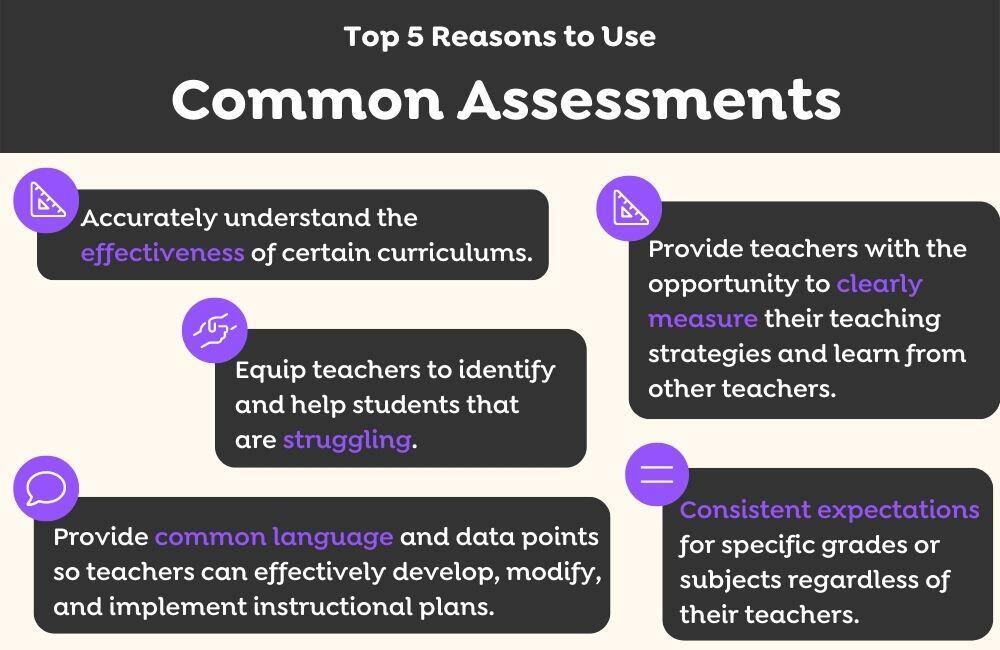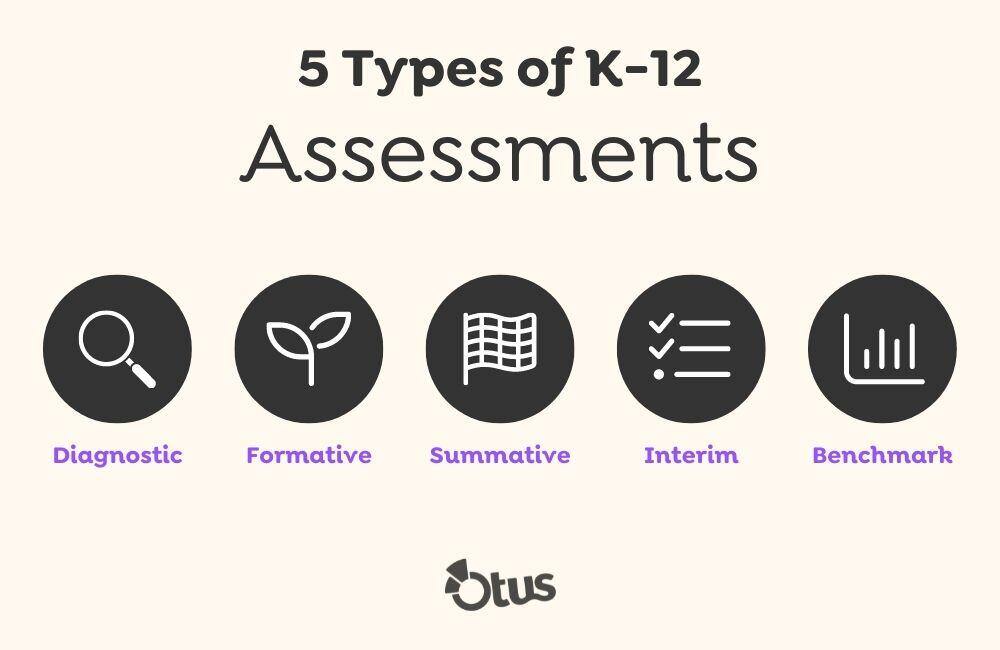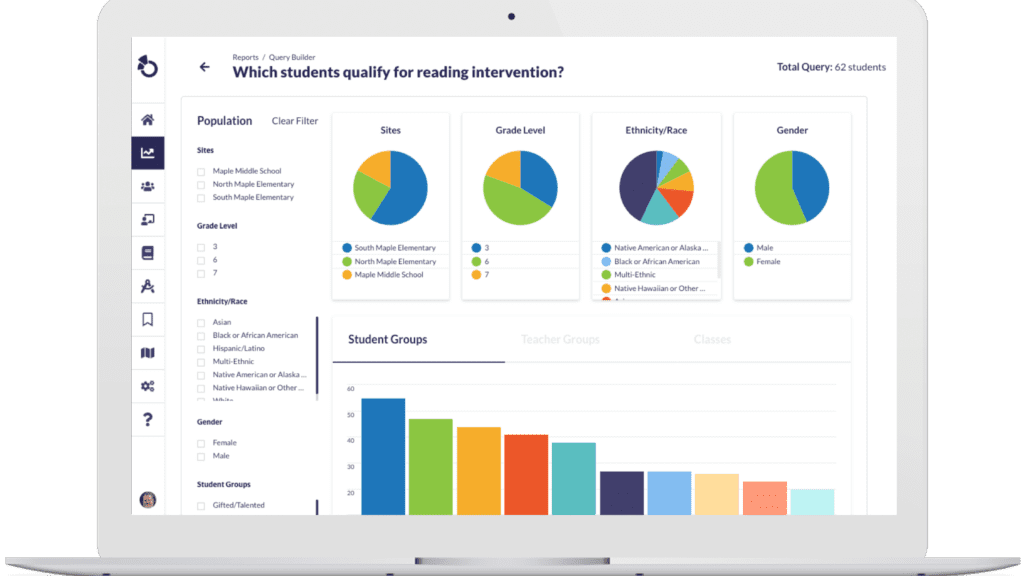The Ultimate Guide to Common Assessments
What are common assessments in education?
Common assessments are tests that at least two teachers give to their students in their respective classrooms. The purpose of common assessments is to provide data so teachers can compare and analyze the results to improve student learning and teacher instruction.
Although there is no single correct way to execute common assessments, teachers find that common assessments are most useful—and, indeed, can be powerfully effective—when they are rooted in professional learning communities from conception through execution to post-analysis.
Common assessments are not standardized tests, although data from standardized tests can be used as a reference point for teachers creating common assessments. Most teachers create a common assessment plan that begins with goals and objectives, influences the instructional plan, and is primarily implemented through formative assessments. Usually, they give a single summative common assessment at the end of the unit. The most important work comes in analyzing the results of common assessments and applying those findings to either intervention or future instruction.
Why are common assessments used in education?
When explaining why common assessments are important in education, many experts refer to the frequently used illustration of apples and oranges. Due to the many factors that can influence a single classroom’s environment and instruction, it is incredibly difficult to get an accurate point of comparison to measure student learning and teacher effectiveness. It can be like comparing apples and oranges. However, when teachers create common learning objectives and measure them with common formative and summative assessments, suddenly they have data that can accurately—and helpfully—be compared: apples to apples.

Having this “apples to apples” data provides both teachers and students with a variety of benefits:
- Common assessments allow teachers to accurately understand the effectiveness of certain curriculums.
- Common assessments provide teachers with the opportunity to clearly measure their teaching strategies and learn from other teachers.
- Common assessments equip teachers to quickly identify where students are struggling and allow them to accurately diagnose where students are struggling.
- Common assessments enable consistent expectations for specific grades or subjects in order to ensure all students are receiving the same instruction, regardless of their teachers.
- Common assessments provide common language and data points so teachers can effectively develop, modify, and implement the best instructional plans possible.
Implementing what they learn from common assessments, teachers are able to improve instructional strategies, teaching methods, and curriculum to ensure students are mastering their learning.
How do common assessments fit in with the 5 types of assessment?
There are five foundational types of assessments:
- Diagnostic assessments, or pre-assessment, which teachers use to gauge students’ pre-knowledge and zone of proximal development. These typically occur once at the beginning of a unit.
- Formative assessments, which teachers use to determine where student knowledge is at mid-unit. These typically occur frequently throughout the unit.
- Summative assessments, which teachers use to determine student growth at the end of a unit. These typically occur once at the end of a unit.
- Interim assessments, which districts use to measure specific grades across schools. These typically occur once a year.
- Benchmark assessments, which bigger bodies (e.g. states) use to measure overarching student growth and school effectiveness. These typically occur once a year.

Notably, common assessments are not one of the five foundational types of assessments. As a fairly new concept, they are not regularly used by all teachers and districts.
In short, common assessments are not a type of assessment. Rather, they are a way of implementing assessments. Again, a common assessment is one that teachers design together and execute within agreed-upon instructional plans in order to compare students in the same grade or subject but in different classrooms. They most commonly occur as diagnostic, formative, and summative assessments.
Some people mistakenly equate benchmark assessments with common assessments. However, because they come from an outside source and do not influence curriculum or instruction, experts do not consider common assessments as equivalent to benchmark assessments.
Depending on how interim assessments are created and used, they could be considered common assessments. It’s important to note, however, that districts that implement interim assessments without teacher input and buy-in rarely find the success of teacher-driven common assessments.
How do you write a common assessment?
Before writing a common assessment, a teacher must find one or more fellow teachers to work alongside, ideally in a professional learning community (PLC). Then, this group must take the following five steps to create a common assessment together.
1. Preparation
First, PLCs must determine the primary learning objective(s) for the coming unit, either from state, district, or common standards. Then they must identify what specific skills they want to ensure students know at the end of the unit, and decide together how they will measure if students have mastered their learning.
The fewer and more specific learning objectives the PLC can choose, the more effective they will be when analyzing what worked and didn’t after giving the common formative and summative assessments.
2. Design
Next, the PLC must together write the summative assessment. This doesn’t have to be all multiple choice; many common assessments take the form of extended writing or performance-based assessments. However, if the PLC moves away from a pure multiple-choice assessment, it is essential that the PLC creates a clear rubric. This is key to ensuring that the data across classrooms remains consistent and simple to analyze.
Additionally, there are many different ways teachers can write the questions, even on a multiple-choice test. Some teachers choose to each share a few questions they’ve used on previous summative assessments to measure them against other teachers’ questions. Other PLCs choose to use questions written by the curriculum they use or pull questions that have been made available by certain standardized tests.
After the common summative assessment is written, the PLC should create the instructional plan for the unit. Although common assessments don’t require that teachers teach the exact same thing in the exact same way on the exact same timeline, it is important that instruction across classrooms is clearly aligned within a similar timeline.
Once an instructional plan is created for the unit, it is important that the PLC also create common formative assessments, and potentially even a common diagnostic assessment, with time during the unit to compare results. This will allow the PLC to begin to analyze student growth and achievement as soon as the unit is launched, and provide them with time to pivot the instructional plan and implement interventions if students are not showing steady, satisfactory growth during the unit.
Again, the formative assessments don’t have to be implemented at exactly the same time, but should be given around the same time. Individual teachers can certainly give more frequent individualized formative assessments and less-formal check-ins on their own initiative; however, they should never skip an agreed-on common formative assessment because it can skew the data needed for analysis at the end of the unit.
3. Delivery
Once all content and material are finalized by the PLC (which will certainly take more than one meeting), the teachers will execute the common assessment plan and will check in on an agreed-upon number of times during the unit to measure student progress and revise as needed.
4. Data
After a formative or summative common assessment, members of the PLC will compare data from the common assessments given and look for any significant trends. Dialogue is key at this stage as they work together to problem-solve. They will use the data and their solutions to target struggling students and then adjust curriculum, instructional practices, assessments, and any other elements that point to improved student learning. Many teachers find online software platforms help immensely with this process.
5. Re-engagement
Finally, teachers will implement the plans they developed together to address struggling students or ineffective curriculum mid-unit or, if the unit is over, they will execute a follow-up unit to ensure that students have ample opportunity to master the standards before moving on to the next unit.
What are examples of common assessments?
There is no one right way to write a common assessment. However, below are common examples of different types of common assessments.
Common formative assessments include exit tickets, check-ins, classroom discussion, short answer questions, pop quizzes, or educational games. When planning formative assessments ahead of time, PLCs are wise to scaffold them so that they become increasingly complex in order to ensure students are truly achieving mastery and not simply parroting what they’ve heard the teacher repeat multiple times. Additionally, a robust formative assessment plan allows teachers to test very specific nuances of the standard they are focusing on that the final summative assessment may not cover.
Common summative assessments include multiple-choice tests, written essays, and presentations. For any non-multiple choice common assessment, clear rubrics are essential. No matter what type of summative common assessment teachers or PLCs choose to use, it’s essential that they provide real data points that can be easily graded, compared, analyzed, and discussed.
Moreover, as PLCs become increasingly comfortable with implementing common assessments, they may choose to map out an entire semester or even year ahead of time, and can create common summative assessments to build on one another throughout the year.
What does a common assessment measure?
At its simplest, a common assessment measures the effectiveness of a teacher, a curriculum, or an instructional plan.
Common assessments measure these three categories by comparing student knowledge across classrooms through the same instruction and assessment so educators have the data necessary to analyze student growth and achievement.
And it’s essential to note that this is where common assessments shine, in the evaluated data. Simply performing common assessments and briefly comparing notes does nothing to move instruction strategies—and therefore, student mastery—forward. It’s only when teachers dialogue and process how and why students performed as they did that they will be able to learn from it.
Moreover, it’s only in learning from the data that teachers can begin to implement data-backed best practices in their classrooms and provide targeted, personalized intervention to struggling students to ensure students are receiving the best possible instruction to master their goals and standards.
However, when common assessments are created by a team of instructors, planned and designed well in advance, administered as similarly as possible by the participating teachers, and analyzed and responded to by a strong team working together to improve student learning, common assessments can be a powerful engine to driving not only student mastery of knowledge, but professional development of instructional methods and strategies in the classroom.
Request a demo!
See exactly how Otus can help your school accelerate student growth and improve student outcomes – all while saving educators time.




